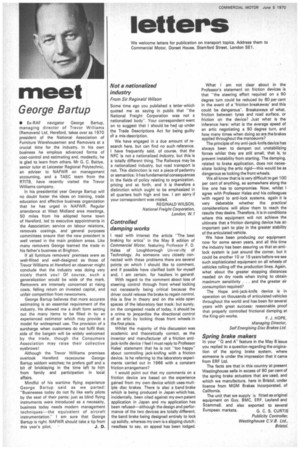Controlled damping works
Page 56

If you've noticed an error in this article please click here to report it so we can fix it.
I read with interest the article "The best braking for attics" in the May 8 edition of Commercial Motor, featuring Professor F. D.
Hales of Loughborough Uni ye' sity of Technology. As someone very closely connected with these problems there are several points on which I should like to comment, and if possible have clarified both for myself and, I am certain, for hauliers in general.
With regard to the comment about loss of steering control through front wheel locking not necessarily being critical because the driver could release the brake to regain control, this is fine in theory and on the wide open spaces of the laboratory test track: but surely, on the congested roads of today, it should be a crime to jeopardize the directional control of an artic by locking those front wheels in the first place.
Whilst the majority of this discussion was academic and theoretically correct, as the inventor and manufacturer of a friction antijack-knife device I feel I must reply to Professor Hales' statement that he is not "too happy" about controlling jack-knifing with a friction device. Is he referring to the laboratory experiments carried out in 1966 with a constant friction arrangement?
would point out that my comments on a friction device are based on the experience gained from my own device which uses multiple disc brakes. There is also a band brake which is being produced in Japan which has, incidentally, been cited against my own patent application in Japan and my application has
been refused although the design and performance of the two devices are totally different, the band brake being designed entirely to lock up solidly, whereas my own is a slipping clutch; needless to say, an appeal has been lodged.
What I am not clear about in the Professor's statement on friction devices is that "the steering effort required on a 90 degree turn could be reduced by 80 per cent in the event of a 'friction breakaway' and this could be dangerous". Breakaways of what, friction between tyres and road surface, or friction on the device? Just what is the inference here: what is the average speed of an attic negotiating a 90 degree turn, and how many times when doing so are the brakes applied throughout the manoeuvre?
The principle of my anti-jack-knife device has always been to dampen out unstabiiizing forces whilst they are still small, that is, to prevent instability from starting. The damping, related to brake application, does not necessitate locking the artic rigid—this would be as dangerous as locking the front wheels.
We all know that is is very difficult to get 100 per cent of anything, so somewhere along the line one has to compromise. Now, whilst I agree with Professor Hales and his colleagues with regard to anti-lock systems, again it is very debatable whether the practical considerations will allow them to reach the results they desire. Therefore, it is in conditions where this equipment will not achieve the ultimate that a friction damping device has an important part to play in the greater stability of the articulated vehicle.
We have been producing our equipment now for some seven years, and all this time the industry has been assuring us that an antilock system is just around the corner, but it could be another 10 or 15 years before we see such sophisticated equipment on all wheels of vehicles rolling off the production lines. Again, what about the greater stopping distances needed on dry roads when trying to obtain maximum sensitivity . . and the greater air consumption required?
The Hope anti-jack-knife device is in operation on thousands of articulated vehicles throughout the world and has been for several years with great success: reasonable proof that properly controlled frictional damping at the King-pin works F. J. HOPE, Managing Director, Self Energising Disc Brakes Ltd.




























































































































































































